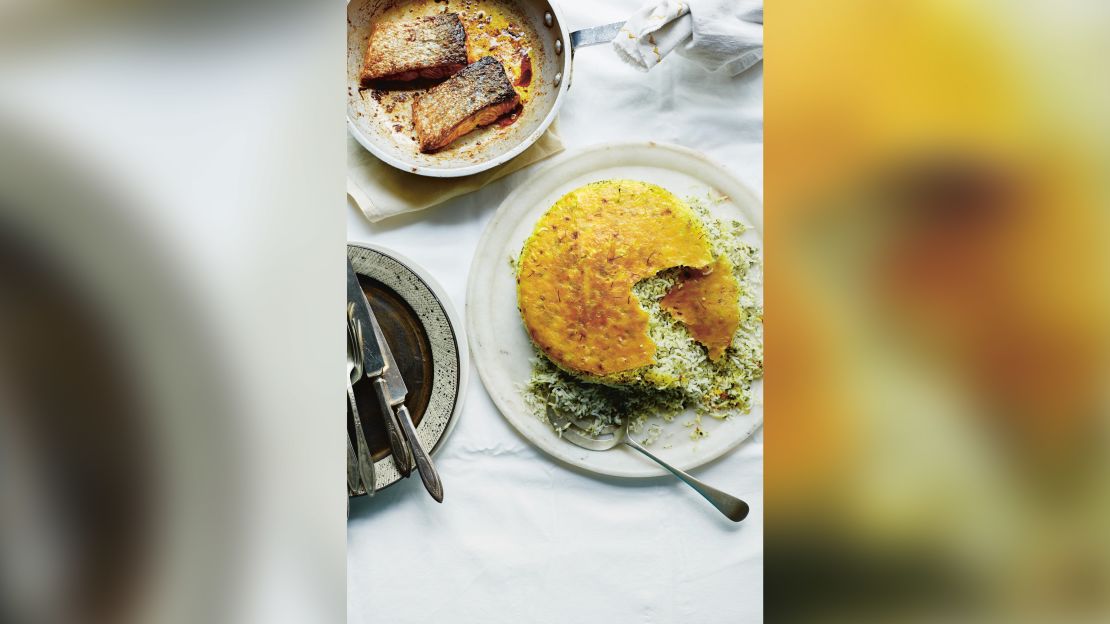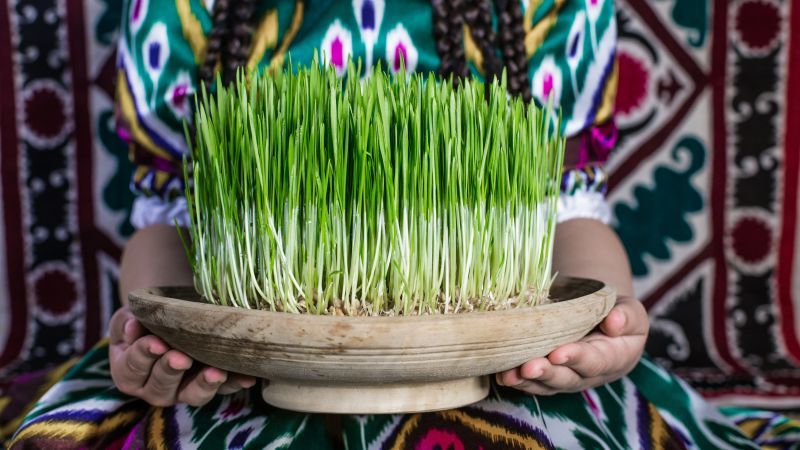Editor's note: Subscribe to CNN's Eat, But Better: Mediterranean Style. Our eight part guide shows you a delicious, expert-backed eating lifestyle that will improve your health for life.
cnn
—
Just as spring is a time of rebirth, the Persian New Year is a time to celebrate new life. Nowruz is celebrated on the spring equinox, which is Tuesday, March 19.
This celebration of spring is filled with symbolism around rebirth and renewal, because spring is a time when life returns after a long, cold winter, said Yasmin Khan, a London-based human rights activist. author of “The Saffron Tales: Recipes.” of Persian Cuisine”, “Zaitoun: Recipes and Stories from Palestinian Cuisine” and “Ripe Figs: Recipes and Stories from the Eastern Mediterranean”.
These three cookbooks by Khan inspire and provide a window into the cultures and stories of the people of the Middle East through food.
The conversation has been edited and condensed for clarity.
CNN: What are some of the traditions and rituals of the Persian New Year?
Yasmin Khan: On the last Tuesday before the New Year, there is a tradition of making small bonfires in the garden. Traditionally people jump over bonfires, and it is supposed to be a symbol of purification, of challenges from the past year, of energetic cleansing and preparation for the coming year.
A key tradition is to set up an altar in your home called Haft-seen, which means seven S's in Farsi. You place seven things on your altar that begin with the letter S in Farsi, which are symbols or qualities that you would like to invite into the coming year. You can have apples for good health, candles for light, eggs for fertility, wheatgrass for rebirth and renewal, vinegar for wisdom, and a gold coin for abundance and prosperity. Each person chooses elements that have meaning for them.
The festival lasts two weeks. At the end of the festival, you take the wheatgrass you've been growing on your altar and take it somewhere with running water. You tie knots in the wheatgrass and then throw it into running water. It would float away along with all your hopes and dreams for the coming year.
CNN: What food is important for the holidays?
Khan: Like any cultural celebration, food is a truly integral part. As it is a festival celebrating spring, we eat a lot of fresh green herbs. For example, there is this dish called Kuku Sabzi (see recipe below), which is a delicious herb and spinach frittata that we always eat on the first day of the year in our house. The frittata is fragrant and aromatic and is served with flatbreads, sliced tomatoes and pickles.
The first meal of the Persian New Year is always fish served with herbed rice and stuffed with dill, parsley and chives. The festival, which lasts two weeks, is a time of celebration with people you know…traditionally you go to people's houses and eat lots of delicious sweets and cakes.
CNN: What are some simple ways people can join in the celebrations?
Khan: Cooking is probably the easiest and most fun way to celebrate the new year. I really recommend people try some Persian recipes. Besides being delicious, they are healthy and vibrant with all the herbs they contain.
In the weeks leading up to the new year, we do a big, thorough spring cleaning called “shaking out the house” in Farsi. It's really wonderful to have a focus and something that is about bringing new life, renewal and rebirth during this difficult time.
And no one regrets a deep clean, so I think it's a great idea too. I think this is a beautiful type of non-religious festival that everyone can join and that we can all relate to. It's a time when we really try to put aside any difficulties we had last year and try to start the new year with a clean slate.
This Iranian frittata is a sensational deep green color and tastes like spring on a plate, bursting with fresh herb flavor. It's incredibly quick to prepare, keeps for a few days in the refrigerator, and can be enjoyed hot or cold.
Serve as an appetizer or as part of a mezze spread, wrapped in a flatbread with a few slices of tomato and some tart and salty fermented pickles, or add some crumbled feta cheese and lightly toasted walnuts for a heartier main dish .
Makes 4 servings as a main dish or 8 servings as a starter
Preparation time: 15 minutes | Total time: 35 minutes
Ingredients
7 ounces|200 grams of spinach
1 3/4 ounces|50 grams fresh parsley
1 3/4 ounces|50 grams fresh dill
2 2/3 ounces|75 grams fresh cilantro
5 medium eggs
1/2 teaspoon turmeric
2 tablespoons all-purpose flour
1 teaspoon sea salt
1 teaspoon freshly ground black pepper
1 teaspoon dried fenugreek leaves
2 teaspoons sunflower oil
2 cloves of garlic, crushed
Instructions
1. Wash the spinach, parsley, dill and cilantro, then dry thoroughly with paper towels or in a salad spinner. Squeeze out as much moisture as possible; If the vegetables are wet when cooking, the kuku will become spongy. Finely chop or puree in a food processor, in a couple of batches.
2. Heat grill to high heat. Crack the eggs into a large mixing bowl. Add turmeric, flour, salt, pepper and fenugreek leaves. Add chopped spinach and herbs.
3. Heat the oil in a large oven-safe skillet. Add the garlic and fry over low heat to soften, about 2 minutes.
4. Make sure the garlic is evenly distributed throughout the pan and then pour in the egg mixture. Simmer until the kuku is almost cooked, 5 to 8 minutes. Finish on hot grill.
5. Let the kuku cool slightly and then cut it into triangular slices to serve.

Makes 4 servings
Ingredients
Marinade
2 cloves garlic, minced
1/2 cup dark soy sauce
Juice of 1 medium lemon
3 tablespoons extra virgin olive oil
A pinch of cayenne pepper (optional)
4 salmon fillets
Rice with mixed herbs
1 3/4 cups white basmati rice
Sea salt
A pinch of saffron threads
A pinch of granulated sugar
2 tablespoons freshly boiled water
1 small bunch fresh parsley, finely chopped
1 small bunch fresh cilantro, finely chopped
2 tablespoons fresh dill, finely chopped
2 tablespoons fresh chives, finely chopped
1 clove garlic, crushed
Sunflower oil
2 tablespoons unsalted butter, divided
Instructions
1. To make the marinade, combine the garlic, soy sauce, lemon juice, olive oil, and cayenne pepper, if using, in a deep bowl. Add the salmon, turn to coat well, cover with plastic wrap and marinate in the refrigerator for at least 30 minutes.
2. Rinse and parboil the rice and prepare the saffron liquid. Place the saffron in a mortar with the sugar and grind until obtaining a fine powder. Add freshly boiled water and let sit for 10 minutes.
3. Very carefully mix the rice, chopped herbs, garlic clove and 1 tablespoon of oil, being careful not to break the rice grains.
4. Preheat oven to 400°F/Gas 6. Place an 8” wide nonstick saucepan with a tight-fitting lid over medium heat. Melt 1 tablespoon butter with 2 tablespoons oil. Add 1 tablespoon of saffron liquid and season with a pinch of salt. Once the fat is hot, sprinkle a thin layer of rice over the bottom and press down firmly to cover the base of the pan. Using a large spoon, gently place the rest of the rice on top, shaping it into a pyramid. Using the handle of a wooden spoon, make 4 holes in the rice. Place the remaining 1 tablespoon butter into the holes and then pour over the rest of the saffron liquid.
5. Place a clean kitchen towel or 4 paper towels on top of the pan and close the lid tightly. Tuck the edges of the dish towel or trim the paper towels to fit, so they don't catch flames. Cook over medium heat for 5 minutes, then reduce heat to very low and cook 15 minutes more. Remove the rice from the heat and let it rest. Don't be tempted to peek while it cooks, as this will disrupt the steaming process. When the rice has cooked for 10 minutes, place the salmon on a baking sheet and bake skin side up until cooked to your liking, 10 to 15 minutes.
6. Once the rice has cooked, fill the sink with 2 inches of cold water and place the saucepan (with the lid still tightly closed) into the water. This will produce a burst of steam that should loosen the base of the rice. Remove the lid, place a large plate on top of the pan, and quickly turn the rice over. Serve the herbed rice with the fish and serve immediately.
These recipes are adapted from Yasmin Khan's book. “The tales of saffron: recipes from Persian cuisine.”












